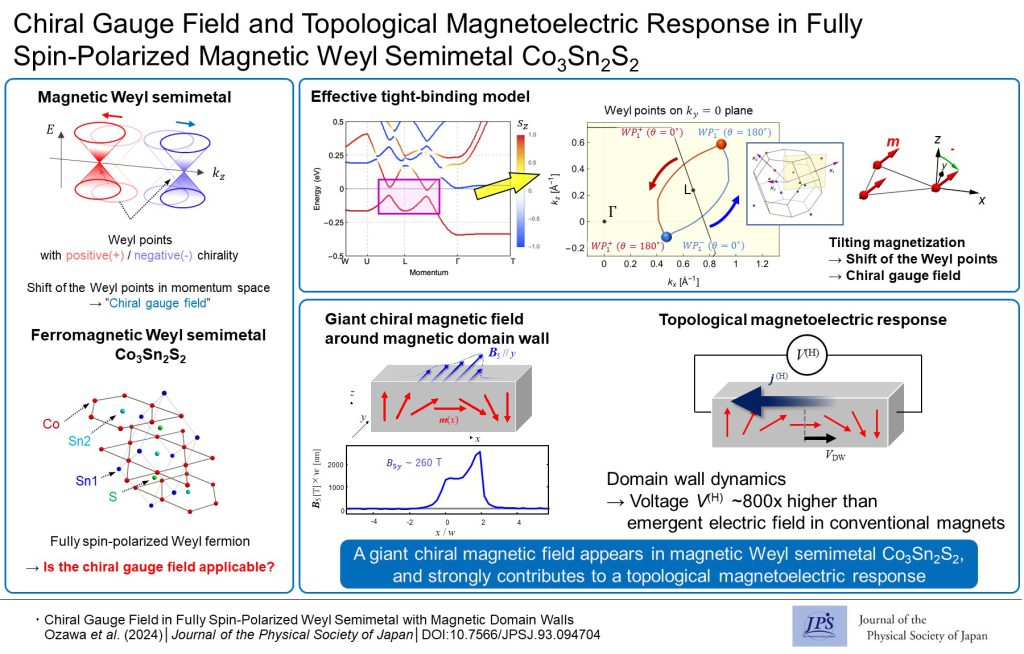Chiral Gauge Field and Topological Magnetoelectric Response in Fully Spin-Polarized Magnetic Weyl Semimetal Co3Sn2S2
© The Physical Society of Japan
This article is on
Chiral Gauge Field in Fully Spin-Polarized Magnetic Weyl Semimetal with Magnetic Domain Walls
(JPSJ Editors' Choice)
J. Phys. Soc. Jpn.
93,
094704
(2024)
.
This study clarifies the relationship between magnetic ordering and chiral gauge fields in the ferromagnetic Weyl semimetal Co3Sn2S2, highlighting its spintronic potential using the topological magnetoelectric responses of Weyl fermions.

Weyl semimetals are a class of materials characterized by the presence of Weyl points where the valence and conduction bands touch linearly. Electrons near these points behave as relativistic fermions called Weyl fermions, contributing to topological magnetoelectric responses, such as the anomalous Hall effect. The concept of chiral gauge field was introduced to understand these topological effects. This fictitious gauge field describes the shifts in the Weyl points in the momentum space. Previous studies have shown that a chiral gauge field can be generated by external perturbations, such as light and lattice strain. This enables one to understand their effects, similar to ordinary electromagnetic fields appearing in Maxwell’s equations.
In magnetic Weyl semimetals, the interplay between the magnetic ordering and the topological magnetoelectric responses is of particular interest. When spin–momentum locking is present, where the spin and momentum of Weyl fermions are parallel or antiparallel, the magnetization can be directly mapped to the chiral gauge field. This correspondence has led to the development of various magnetoelectric responses with potential spintronic functionalities. However, the spin–momentum locking structure depends on both spin–orbit coupling and spin polarization. This hinders the understanding of the topological magnetoelectric responses in realistic magnetic Weyl semimetals based on a chiral gauge field.
This study investigated the chiral gauge field in relation to the magnetization in the Weyl ferromagnet Co3Sn2S2. The electrons in Co3Sn2S2 are nearly fully spin-polarized, leading to the absence of spin–momentum locking around the Weyl points. The effective model calculations in this study demonstrated that the positions of the Weyl points are significantly influenced by magnetization modulation, which can be described by the chiral gauge field. This result attributes the temporal and spatial variations in the magnetization within Co3Sn2S2 to the chiral electric and magnetic fields. The calculations demonstrated that a magnetic domain wall with a width of 10 nm generates a large chiral magnetic field of 260 T, leading to topological magnetoelectric responses. One consequence is the charge pumping driven by domain wall dynamics, which is analogous to the quantum Hall effect induced by chiral electromagnetic fields. This effect results in an electric voltage up to 800 times higher than the spin motive force observed in conventional ferromagnetic metals. This makes Co3Sn2S2 a promising material for detecting domain wall dynamics in spintronic devices, such as magnetic memories.
The insights gained from this study on the chiral gauge field in magnetic Weyl semimetals are expected to stimulate further exploration of novel topological magnetoelectric responses associated with magnetic textures and dynamics.
(Written by A. Ozawa and Y. Araki on behalf of all the authors)
Chiral Gauge Field in Fully Spin-Polarized Magnetic Weyl Semimetal with Magnetic Domain Walls
(JPSJ Editors' Choice)
J. Phys. Soc. Jpn.
93,
094704
(2024)
.
Share this topic
Fields
Related Articles
-
Higher-Order Topological Phases in Magnetic Materials with Breathing Pyrochlore Structures
Electronic structure and electrical properties of surfaces and nanostructures
Magnetic properties in condensed matter
Mathematical methods, classical and quantum physics, relativity, gravitation, numerical simulation, computational modeling
2025-4-7
A simple example of a higher-order topological phase, in which the symmetry decreases step-by-step from the bulk to the corner, is realized in a magnetic system with a pyrochlore structure and is characterized by a series of quantized Berry phases defined for the bulk, surface, and edge.
-
Existence of Chiral Soliton Lattices (CSLs) in Chiral Helimagnet Yb(Ni1-xCux)3Al9
Magnetic properties in condensed matter
2025-4-1
Our study examines the magnetic structure of the monoaxial chiral helimagnet Yb(Ni1-xCux)3Al9, providing first direct evidence of the formation of chiral soliton lattice state.
-
Understanding Pressure-Induced Superconductivity in CrAs and MnP
Magnetic properties in condensed matter
2025-3-10
This study reviews existing research on the pressure-induced variation of magnetic properties of transition metal mono-pnictides like CrAS, MnP, and others, aiming to understand the unconventional superconductivity observed in CrAs and MnP.
-
A Unified Theory of Topological Hall Effect
Electronic transport in condensed matter
2025-3-6
This paper presents a unified theoretical description for the topological Hall effect, covering the entire region from strong- to weak-coupling, extending its picture beyond the Berry phase.
-
Excitonic Insulators: Challenges in Realizing a Theoretically Predicted State of Matter
Electron states in condensed matter
Electronic transport in condensed matter
2025-3-3
The realization of an excitonic insulator can help in the establishment of a new electronic state in condensed matter physics, one that has the potential to exhibit novel electric, magnetic, and optical responses beyond those of conventional materials.




